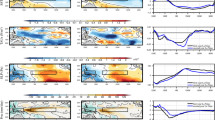Abstract
A detailed analysis of hydrology, hydrodynamics, and microstructure of an anticyclonic eddy is performed. We use the field data obtained in May 2004 at the shelf edge in the northwestern part of the Black Sea. We study the spatial distributions of the Brunt-Väisäl number, and regions of mixing with a vertical scale on the order of 2 m. Possible mechanisms of generation and maintenance of the observed mixed layers are analyzed. A conclusion is made that the investigated eddy in the northwestern part of the Black Sea (possibly similar to the other natural eddies in the northwestern part of the Black Sea) is able to modify the fine layered structure of the scalar hydrophysical fields in the upper 150-m layer forming and maintaining the layers of low vertical gradients with vertical scales of ∼2 m and up to 50–100 km in the horizontal direction owing to the local shear instability of the horizontal flow.
Similar content being viewed by others
References
M. C. Gregg, “Scaling turbulent dissipation in the thermocline,” J. Geophys. Res. 94(C7), 9686–9698 (1989).
A. S. Samodurov, A. A. Lyubitskii, and N. A. Panteleev, “Contribution of disturbing internal waves to the structure formation, energy dissipation, and vertical diffusion in the ocean,” Morsk. Gidrofiz. Zh., No 3, 14–27 (1994).
A. S. Samodurov and L. I. Ivanov, “Mixing and energy dissipation rate in Mediterranean seas: An intercomparison of existing models,” in Oceanography of the Eastern Mediterranean and Black Sea: Similarities and Differences in Two Interconnected Basins, Ed. by A. Yilmaz (Tubitak, Ankara, 2003), pp. 369–375.
A. E. Gargett and G. Holloway, “Dissipation and diffusion by internal wave breaking,” J. Mar. Res. 42(1), 15–27 (1984).
A. E. Gargett, “Vertical eddy diffusivity in the ocean interior,” J. Mar. Res. 42, 359–393 (1984).
A. S. Samodurov and L. V. Globina, “Energy dissipation and vertical exchange in stratified basins due to shear instability in the field of quasi-inertial internal waves,” Morsk. Gidrofiz. Zh., No. 6, 16–27 (2011).
A. S. Samodurov and L. V. Globina, “Dependence of the rate of turbulent energy dissipation and vertical exchange on stratification on the basis of generalized experimental data (comparison with existing models),” Morsk. Gidrofiz. Zh., No. 6, 17–34 (2012).
V. A. Ivanov, A. S. Samodurov, A. M. Chukharev, and A. V. Nosova, “Intensification of the vertical turbulent exchange in areas of interface between the shelf and continental slope in the Black Sea,” Dopovidi Nats. Akad. Nauk Ukr., No. 6, 108–112 (2008).
A. S. Samodurov and A. M. Chukharev, “Experimental estimation of the vertical turbulent exchange coefficient in the stratified layer of the Black Sea near a depth decline,” Morsk. Gidrofiz. Zh., No. 6, 14–24 (2008).
Author information
Authors and Affiliations
Corresponding author
Additional information
Original Russian Text © A.E. Pogrebnoi, A.S. Samodurov, 2014, published in Izvestiya AN. Fizika Atmosfery i Okeana, 2014, Vol. 50, No. 6, pp. 704–713.
Rights and permissions
About this article
Cite this article
Pogrebnoi, A.E., Samodurov, A.S. Evolution of mixed layers in a stratified region of the Black Sea anticyclonic eddy. Izv. Atmos. Ocean. Phys. 50, 621–629 (2014). https://doi.org/10.1134/S0001433814060127
Received:
Accepted:
Published:
Issue Date:
DOI: https://doi.org/10.1134/S0001433814060127




